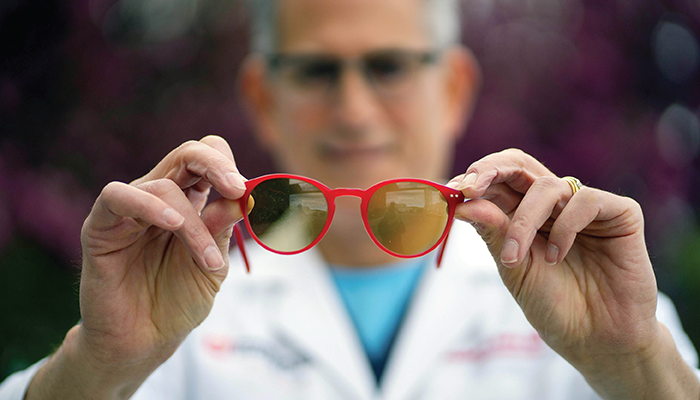
Images supplied by Brad Katz
What inspired you to get involved in migraine research?
I noticed that patients were regularly complaining of light sensitivity – photophobia – but they didn't really have any trouble outdoors. Out in the sun, they'd put on a pair of sunglasses and be fine. It was artificial indoor light – fluorescent lights, LEDs – causing these issues. The lights in “big-box stores” – Costco, Home Depot, and so on – for example, are gas discharge lamps, and it can really affect people with migraine because they're a non-incandescent artificial light.
Then, Kathleen Digre, my colleague at the John A. Moran Eye Center, heard about a tinted pair of glasses – invented in Birmingham, UK – called the FL-41, which were originally developed for people with fluorescent light sensitivity. She found that, anecdotally, these lenses could also be helpful for people who suffer from migraines. So I started prescribing this tint to patients with indoor light sensitivity, and I was stunned by how helpful it was – these patients were able to go back to school, back to work, back to their everyday lives. With a collaborator – Robert McClane, who did the spectral analysis on the lenses – I did some research to find out which light wavelengths were specifically blocked by this tint, and it turned out that FL-41 blocks a blue-green part of the visible spectrum.
A few years later came the discovery of intrinsically photosensitive retinal ganglion cells (IPRGCs) in the eye that are light sensitive but have nothing to do with vision. They’re a small subset of cells primarily responsible for circadian rhythm, and they also connect to pain centers in the brain. So, if we look at a light that's too bright, it physically causes us pain, which is a protective mechanism that keeps us from damaging our eyes.
Our theory is that, in some people, these cells are a bit too sensitive to levels of light that wouldn’t ordinarily be bothersome. They are specifically sensitive to the wavelength of light that FL-41 blocks. When I discovered this, it inspired me to work with an optical engineer to work out how to more effectively block the wavelengths of light that trigger those cells in the eye, and this led to the development of Avulux.
Can you tell us about the Avulux lenses?
There are two wavelengths of light that activate IPRGCs – 480 nanometers and 590 nanometers; FL-41 is really good at blocking 480, but not so good at blocking 590, while Avulux blocks both.
Rami Burstein, a researcher at Harvard, has shown that patients with migraine prefer green light. Avulux is very good at transmitting green and very good at blocking both 480 and 590. Also, if you're wearing a tint indoors, it can't be too dark; you have to see what you’re doing and you probably don’t want to look like a rockstar wearing sunglasses indoors. It took a long time to find the correct balance of blocking those wavelengths, transmitting green, not being too dark, not being too light, and avoiding color distortion. FL-41 creates a sort of a rose color, while Avulux is much more of a neutral gray, which gives much less color distortion.
It should be noted that the lens is not a cure for migraine headaches. Around 80 percent of people with migraine have light sensitivity, and then there are people for whom certain kinds of light – such as fluorescent lights – can trigger a migraine. The tint is really made to be worn by the people that are light-sensitive during a migraine attack.
What was the technical solution to finding the right balance?
The easiest way to get the balance I mentioned earlier is with a technology called thin films – ultrathin films of metal oxide that you can put on a lens that are generally used for anti-glare coatings. Steve Blair was the optical engineer who created the first design using these thin films, with Tecport Optics producing the lenses. We initially used this technology to get the optical characteristics we were looking for, but it turned out to be so expensive and so difficult to manufacture consistently, that it was non-viable from a business perspective. So we went back to using organic dyes that can be put into a lens. These dyes are much less expensive, but it took years of iterative trial and error to find the combination of organic dyes that would give us the right properties. Charles Posternack – the heart and soul of Avulux – was the person who drove this research into these dyes that would ultimately become the Avulux product.
Also when you're making a prescription lens, you start with what's called a blank, and the lab grinds the blank down to get the required prescription. But if your organic dyes are in that plastic, when the lab grinds down your prescription you don't have as much tint as you did in the original blank. So you have to create blanks that can be ground without reducing those ideal optical properties, which is also technically challenging.
What are your next steps?
The next thing is to make physicians and patients more aware of this technology, so that it can become a regular part of the migraine-treating armamentarium. It will take a big science and marketing campaign to get the word out about light sensitivity and why it’s such an important aspect of migraine.
One positive driver for Avulux adoption may be the fact that some migraine sufferers are increasingly reluctant to take medication for migraine – that’s something I see in my practice. But, of course, they – or their physician or eye care provider – will need to know about the option first!

Brad Katz is a neuro-ophthalmologist and scientist at the University of Utah’s John A. Moran Eye Center.
